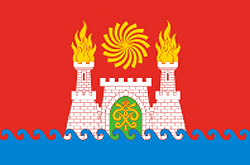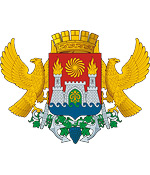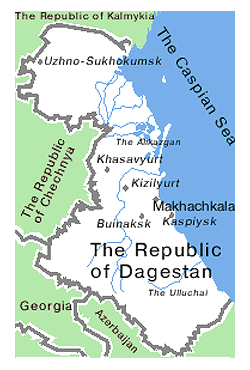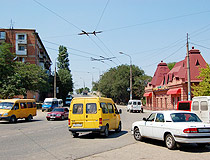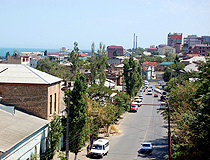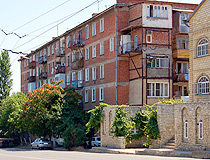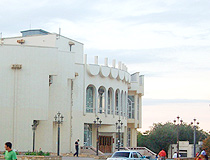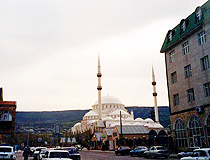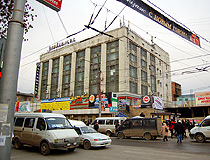History of Makhachkala
Foundation of Makhachkala
For centuries, the Huns, Persians, and Arabs fought for control over the “Dagestan passage” (the passage through the Caucasus Mountains along the western coast of the Caspian Sea). The village of Tarki, located not far from today’s Makhachkala, played an important role in these events. The caravan route to Derbent, one of the most ancient towns in the world, passed through it. Since the Middle Ages, it was known under the name of Inzhi (later Anzhi).
In 1844, during the Caucasian War of 1817-1864, on the highland of Anzhi-Arka, the Russian fortification of Petrovskoye was founded. It was named in memory of the stay of Peter I in this area during the Persian campaign of 1722-1723.
The construction of the fortified settlement pursued several goals: strengthening control over the road passing through Tarki along the Caspian coast to Derbent (the oldest route connecting the countries of the East with the North Caucasus and Russia); improving the safety of Tarki; protection of the coastal area suitable for the construction of a seaport in the future. In 1857, the fortified settlement became a town named Petrovsk (also known as Petrovsk-Port). In 1861, the population of the town was about 2,100 people.
An artificial harbor and port were built in 1870. The first industrial enterprise in the town was a brewery built in 1876. In 1878, the first printing house began to work. Later, two tobacco factories were built. In 1894-1896, Petrovsk was connected by railways with Vladikavkaz and Baku, the intensive development of the town began.
By 1897, its population increased more than 4 times and exceeded 9 thousand people. In 1899, “Caspian Manufactory”, the largest cotton factory in the North Caucasus, was built in the town and employed up to 1,000 workers.
More Historical Facts…
Makhachkala in the 20th century and beyond
In 1914, a small oil refinery was constructed. Fishing became one of the priority directions of the town’s development. The population of Petrovsk was about 25 thousand people. It became the largest town of Dagestan in terms of population and economic importance. The town of Temir-Khan-Shura (Buynaksk) remained the administrative and political center of Dagestan.
In 1915, the Petrovsk - Temir-Khan-Shura railway line was built. It connected the town with mountainous Dagestan. The streets in the central part were paved with cobblestones and lit with kerosene lanterns. There were stone and brick houses in which officials, officers and clergymen, wealthy townspeople lived.
During the Russian Civil War of 1917-1920, Petrovsk-Port changed hands several times. On the maps of the 1920s, along with the name Petrovsk, the old name Anzhi was also mentioned.
On May 14, 1921, by order of the Dagestan Revolutionary Committee, the town of Petrovsk was renamed into Makhachkala, in honor of the Dagestan revolutionary Makhach Dakhadayev (1882-1918). On December 15, 1923, Makhachkala became the capital of the Dagestan Autonomous Soviet Socialist Republic. In 1926, the population of Makhachkala was about 34,000 people.
During Soviet times, the capital of Dagestan developed rapidly. From the 1930s to the 1980s, the population increased by more than 10 times. Basic industries and social infrastructure were created. The problem of water supply was solved, dozens of educational, medical, and cultural institutions were opened.
Significant changes in all spheres of city life took place in the post-war 1950s-1970s. In 1969, there were 4 universities in Makhachkala: Dagestan State University, Dagestan State Agricultural Academy, Dagestan State Medical Academy, and Dagestan State Pedagogical University, 51 comprehensive schools, dozens of libraries. Makhachkala suffered greatly during the earthquake on May 14, 1970. In 1989, the population of Makhachkala was about 317,000 people.
In connection with the collapse of the USSR, the beginning of economic reforms, and the transition to a market economy, the industry of Makhachkala, mainly focused on supplying the Soviet military-industrial complex, found itself in a difficult situation. In the 1990s, there was a steady decline in production. Several large industrial plants were closed. In the late 1990s, the situation began to improve.
The beginning of the 21st century was marked by significant positive changes in the structure of production and building up the industrial potential of Makhachkala. In the 2000s, several settlements became part of the city. In 2019, its population exceeded 600 thousand people.
Streets of Makhachkala
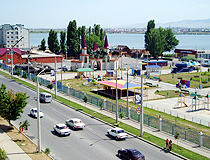
Summer in Makhachkala
Author: Gimbat Sheykhov
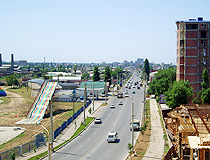
On the street in Makhachkala
Author: Gimbat Sheykhov
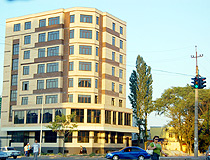
Architecture of Makhachkala
Author: Zemfira Makueva
Makhachkala - Features
Makhachkala is the most populated city in the North Caucasian Federal District and the fastest growing large city in Russia. It has become a center of attraction for a lot of people of the North Caucasus, who want to relocate from the countryside.
It is one of the few large cities in the country where Russians don’t constitute an absolute ethnic majority. In Makhachkala, they are only the sixth largest population group, the first five are Avars, Kumyks, Dargins, Lezgins, and Laks (indigenous peoples of the Caucasus). About 90% of Makhachkala residents are Sunni Muslims.
The city is located near the foothills of the Greater Caucasus, on a narrow strip (up to 10 km wide) of the low-lying plain of the western coast of the Caspian Sea between Mount Tarki-Tau and the sea.
Makhachkala is named after one of the organizers of Soviet power in Dagestan - Magomed Ali (Makhach) Dakhadaev (1882-1918). “Makhach” is the Avar abbreviated form of the name “Magomed”, “kala” - from the Turkic “town, fortress”. Initially, the name of the city was written with a hyphen - Makhach-Kala.
The climate of Makhachkala is arid, moderately continental. Summer is hot, the average July temperature is plus 24.6 degrees Celsius. The summer period (with temperatures above plus 15 degrees Celsius) lasts about 150 days. There is no climatic winter, the average temperature of the coldest months, January and February, is plus 1.2 degrees Celsius, no permanent snow cover is formed.
There are almost no large industrial plants near the city, the number of cars per capita in Makhachkala is noticeably lower than in many cities in the central part of Russia. It has a lot of greenery (parks, trees in the courtyards of residential buildings, lawns, and flower beds). The wind blowing from the mountains and the sea carries away the city dust and pollution. That’s why the air in Makhachkala is quite clean and fresh.
Industry in Makhachkala is poorly developed. Several large enterprises operating in the city belong to the construction industry or are subsidiaries of large Russian, mainly oil and gas, enterprises.
Makhachkala International Airport (Uytash) offers regular flights to Moscow, St. Petersburg, Rostov-on-Don, Sochi, Samara, Surgut, Kazan, Yekaterinburg, Tyumen, and several other destinations.
Makhachkala International Sea Trade Port includes a railway ferry and a car ferry terminal. The largest oil depot in the North Caucasus is located on the territory adjacent to the port. It is connected to the Baku-Novorossiysk oil pipeline.
The city is a major tourist and health-improving center. Due to its warm climate and favorable geomagnetic conditions, a large number of sanatoriums and medical centers are located near Makhachkala. The tourist attraction of the city is facilitated by the amazing Caucasian nature, the geographic location of the city (on the coast of the Caspian Sea), its unique multinational culture and architectural originality.
Main Attractions of Makhachkala
Grand Mosque of Makhachkala (1991-1995) - the main mosque of the city and one of the symbols of Makhachkala built in the image of the famous Istanbul Blue Mosque with the help of Muslims from Turkey. In 2004-2007, the mosque was reconstructed. Today, the maximum number of parishioners who can simultaneously visit the mosque is 15 thousand people. This is one of the largest mosques in Europe. Dakhadayeva Street, 136.
Holy Dormition Cathedral (1905-1906) - the main Orthodox church in Dagestan. This one-domed cathedral with a yellow-and-white facade and blue domes looks surprisingly elegant and is included in the register of architectural monuments of republican significance. Ordzhonikidze Street, 148.
National Museum of the Republic of Dagestan named after A. Takho-Godi - the largest of similar museums in the North Caucasus. The permanent exhibition occupies 19 halls. The exposition includes archaeological finds, old manuscripts, collections of paintings, objects of decorative and applied art. The collections of cold weapons, medals, and old coins deserve special attention. Daniyalova A.D. Street, 33.
Dagestan Museum of Fine Arts named after P. S. Gamzatova. In 10 halls of the permanent exhibition of this museum, you can see works of Dagestan and foreign masters - painting, graphics, sculpture, ceramics, woodcarving, copper, carpets, furniture, glass, porcelain, faience - from the 2nd millennium BC until now. There is also a gift shop in this building. Maksima Gorkogo Street, 8.
Museum-reserve “Ethnographic complex Dagestan aul”. There are four exhibition halls in this museum. In the Large Hall, you can see traditional clothes of the Dagestan peoples, jewelry, household items. The Small Hall is stylized as the interior of a mountain dwelling. The hall “Workshop of Crafts” is dedicated to the traditional crafts of the peoples of Dagestan. The exhibition hall for temporary exhibitions presents modern designer clothes with ethnic motives of the region and contemporary art products. Buynakskogo Street, 9.
Other cultural institutions of Makhachkala: Dagestan State Russian Drama Theater named after M. Gorky (Rasula Gamzatova Avenue, 38), Kumyk Music and Drama Theater named after A.P. Salavatov (Buynakskogo Street, 10), Avar Music and Drama Theater named after Gamzat Tsadasa (Pushkina Street, 1), Dagestan Puppet Theater (Rasula Gamzatova Avenue, 40), Poetry Theater (Rasula Gamzatova Avenue, 12).
Petrovsky Lighthouse (1866) - one of the oldest buildings in the city and its symbol. This hexagonal tower has become an integral part of the cityscape. The lighthouse faced with red and white bricks is 27 meters high. It is clearly visible from any part of the historic center of the city. 117 steps of a spiral staircase lead to the observation deck. Amirkhanova Street, 22.
Monument to Makhach Dakhadayev (1971) on the square in front of the Makhachkala Railway Station. This equestrian bronze sculpture of a fighter for Soviet power, placed on a pedestal made of stone blocks, is one of the iconic monuments of Makhachkala. Magomed-Ali (Makhach) Dakhadayev (1882-1918) was a public and political figure in Dagestan at the beginning of the 20th century, a Bolshevik. In 1921, in his memory, the city was renamed Makhachkala. V. Emirova Street, 10.
Monument to the “Russian Teacher” (2006). The name is unofficial and given by the appearance of the monument - a woman with a book in her hand leaning on a globe. The height of the figure is about 10 meters. A wide staircase leads to the monument. The composition is dedicated to ethnic Russians who came to Dagestan to help in the development of the republic. Komsomolskiy Avenue, 59.
Tarki-Tau - a huge table-like mount rising above the capital of Dagestan at a distance of three kilometers from the Caspian coast. The absolute height of the mountain is 720 m. The name is translated as “narrow mountain”, like the eponymous village, which was once located here. The history of Tarki-Tau goes back many centuries. The first Khazar settlements appeared here in the 8th century.
Sarykum Sand Dune - a picturesque piece of desert located among the mountains about 18 km from Makhachkala. Its name is translated from Kumyk as “yellow sand”. Its length is 12 km, width - about 4 km, height - up to 250 meters. The peculiarities of the terrain and climate have led to the appearance of some species of fauna characteristic of Central Asia. Scientists associate the formation of the dune with the centuries-old blowing of sand from surrounding rocks.


